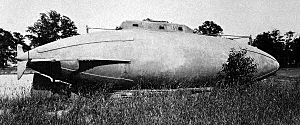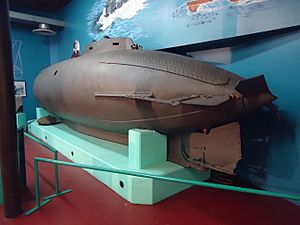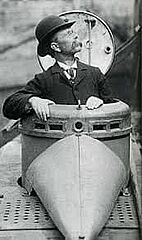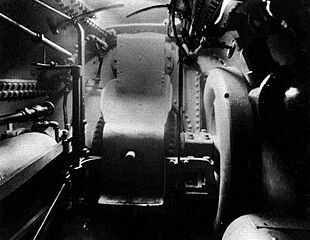Fenian Ram facts for kids

Fenian Ram at the Clason Point Military Academy, Bronx, NY, some time between 1916 and 1927
|
|
Quick facts for kids History |
|
|---|---|
| Name | Holland Boat No. II |
| Owner | Fenian Brotherhood |
| Builder | DeLamater Iron Works, New York City for John Philip Holland |
| Launched | 1881 |
| Nickname(s) | Fenian Ram |
| Status | Museum ship |
| General characteristics | |
| Type | Submarine |
| Displacement | 19 long tons (19 t) |
| Length | 9.4 m (30 ft 10 in) |
| Beam | 1.8 m (5 ft 11 in) |
| Height | 1.8 m (5 ft 11 in) |
| Propulsion | 1 × 15 hp (11 kW) Brayton piston engine, single screw |
| Test depth | 18 m (59 ft) |
| Complement | 3 (operator, engineer, gunner) |
| Armament | 1 × 9 in (230 mm) pneumatic gun |
The Fenian Ram is a special submarine that was designed by John Philip Holland. It was built for a group called the Fenian Brotherhood. This group was an Irish-American organization. They wanted to help Ireland gain independence from the British.
The Fenian Ram was very important because it was one of the first submarines that actually worked well. It used a special engine called a Brayton Ready Motor, which ran on kerosene fuel. This allowed it to dive underwater and come back up successfully. The money to build the Ram came from the Fenians' Skirmishing Fund. It was built in 1881 by the DeLamater Iron Company in New York. Its official name was Holland Boat No. II, but a newspaper called it the Fenian Ram because of who paid for it.
How the Fenian Ram Was Designed
The Fenian Ram was partly inspired by the Whitehead torpedo. It had control fins near its tail, similar to a torpedo. Unlike some other early submarines, it didn't just fill with water until it sank. Instead, it stayed a little bit floaty. It used its horizontal fins to push itself underwater as it moved forward.
The Fenian Ram had a special weapon. It was a 9-inch (229 mm) air-powered gun, about 11 feet (3.4 m) long. This gun was placed in the front of the submarine. It worked a lot like modern torpedo tubes. First, a waterproof cap at the front was closed. Then, a 6-foot-long (1.8 m) steel projectile, filled with dynamite, was loaded inside. After that, the inner door was closed, and the outer cap was opened using a remote control. Finally, air at 400 psi (2.8 MPa) pressure was used to shoot the projectile out. To reload, the outer cap was closed again. The water in the tube was then pushed out into a special tank using more compressed air. The submarine was powered by a 15 hp (11 kW) Brayton piston engine.
History of the Submarine

John Philip Holland did many tests with the Fenian Ram. He made it dive many times and even fired the gun using practice projectiles. However, there were disagreements about money between Holland and the Fenian Brotherhood. Because of this, the Fenians took the Fenian Ram and another prototype submarine, the Holland III, in November 1883. The Holland III accidentally sank in the East River. But the Fenians took the Fenian Ram to New Haven, Connecticut.
Once they had it, the Fenians realized they didn't know how to operate the submarine. Holland refused to help them. Since they couldn't use or sell the boat, the Fenian Brotherhood moved the Ram into a shed near the Mill River.
Years later, in 1916, the Fenian Ram was shown at Madison Square Garden. This was done to raise money for people affected by the Easter Rising in Ireland. After that, it was moved to the Clason Point Military Academy in the Bronx, New York. In 1927, the Academy moved, and the submarine was going to be sold for scrap metal.
However, an Irish-American activist named Harry Cunningham stepped in. He bought the Fenian Ram from the junkyard. He wanted to save it as a symbol of Irish-American cleverness. In September 1927, Cunningham sold the submarine to Edward Browne of Paterson, New Jersey. Mr. Browne then gave the submarine to the City of Paterson. It was meant to be a memorial to John Philip Holland's important work. Today, you can still see the Fenian Ram at the Paterson Museum.
After these events, John Philip Holland went on to start his own company, the Holland Torpedo Boat Company, in 1896. This happened after the U.S. Navy became interested in his submarine designs.
Gallery
See also
- History of submarines
- Holland I
- Holland III
- Holland IV






